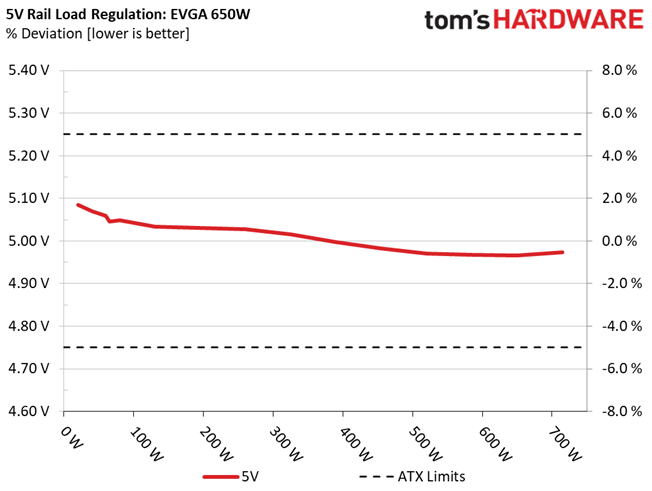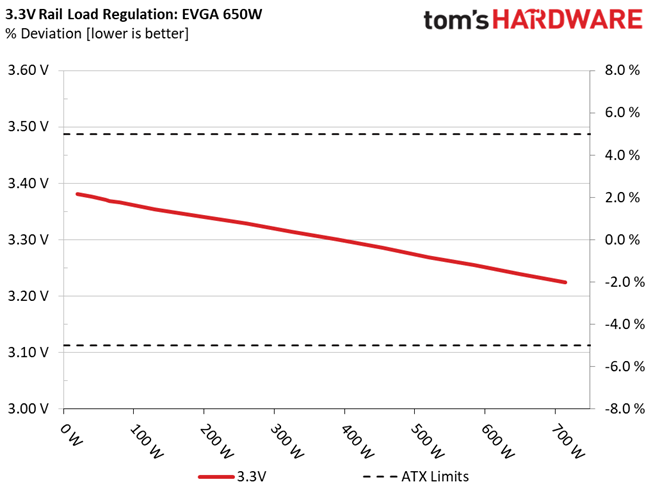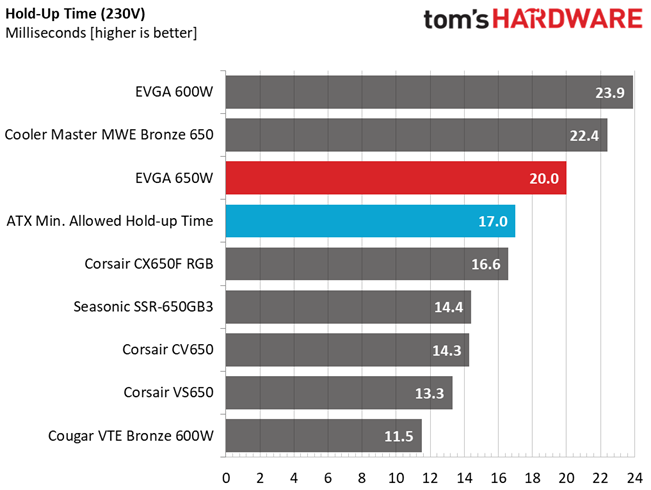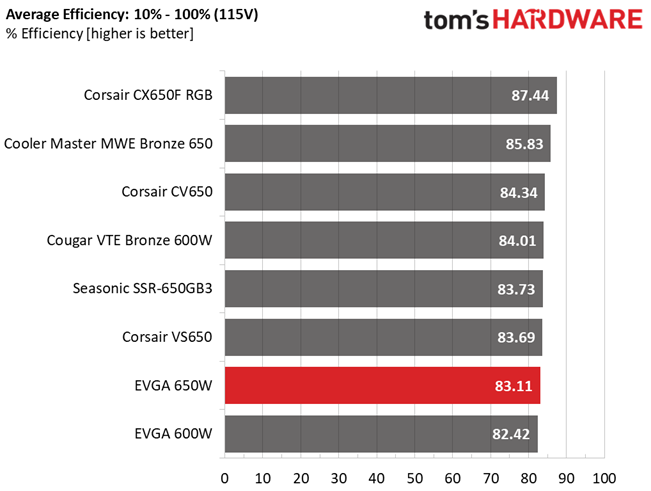Why you can trust Tom's Hardware
To learn more about our PSU tests and methodology, please check out How We Test Power Supply Units.
Primary Rails And 5VSB Load Regulation
The following charts show the main rails' voltage values recorded between a range of 40W up to the PSU's maximum specified load, along with the deviation (in percent). Tight regulation is an important consideration every time we review a power supply because it facilitates constant voltage levels despite varying loads. Tight load regulation also, among other factors, improves the system’s stability, especially under overclocked conditions and, at the same time, it applies less stress to the DC-DC converters that many system components utilize.

Results 1-8: Load Regulation







Load regulation is loose on most rails, especially at 12V and 3.3V.
Hold-Up Time
Put simply; hold-up time is the amount of time that the system can continue to run without shutting down or rebooting during a power interruption.

Results 9-12: Hold-Up Time






The hold-up time is quite long, but the power ok signal's hold-up time does not reach 16ms, as it should.
Inrush Current
Inrush current, or switch-on surge, refers to the maximum, instantaneous input current drawn by an electrical device when it is first turned on. A large enough inrush current can cause circuit breakers and fuses to trip. It can also damage switches, relays, and bridge rectifiers. As a result, the lower the inrush current of a PSU right as it is turned on, the better.

Results 13-14: Inrush Current

The inrush current with both 115V and 230V is low.
Get Tom's Hardware's best news and in-depth reviews, straight to your inbox.
Leakage Current
In layman's terms, leakage current is the unwanted transfer of energy from one circuit to another. In power supplies, it is the current flowing from the primary side to the ground or the chassis, which in the majority of cases is connected to the ground. For measuring leakage current, we use a GW Instek GPT-9904 electrical safety tester instrument.
The leakage current test is conducted at 110% of the DUT's rated voltage input (so for a 230-240V device, we should conduct the test with 253-264V input). The maximum acceptable limit of a leakage current is 3.5 mA and it is defined by the IEC-60950-1 regulation, ensuring that the current is low and will not harm any person coming in contact with the power supply's chassis.

Leakage current is low and this is good, of course.
10-110% Load Tests
These tests reveal the PSU's load regulation and efficiency levels under high ambient temperatures. They also show how the fan speed profile behaves under increased operating temperatures.
| Test # | 12V | 5V | 3.3V | 5VSB | DC/AC (Watts) | Efficiency | Fan Speed (RPM) | PSU Noise (dB[A]) | Temps (In/Out) | PF/AC Volts |
| 1 | 3.542A | 1.983A | 1.958A | 0.972A | 64.963 | 77.838% | 832 | 18.2 | 30.81°C | 0.975 |
| 12.243V | 5.045V | 3.368V | 5.144V | 83.459 | 34.56°C | 115.18V | ||||
| 2 | 8.116A | 2.979A | 2.952A | 1.171A | 130.032 | 83.396% | 862 | 19.2 | 30.97°C | 0.984 |
| 12.215V | 5.033V | 3.354V | 5.124V | 155.921 | 35.23°C | 115.17V | ||||
| 3 | 13.055A | 3.479A | 3.457A | 1.371A | 195.036 | 85.025% | 923 | 21.5 | 31.30°C | 0.981 |
| 12.178V | 5.031V | 3.341V | 5.106V | 229.386 | 36.45°C | 115.16V | ||||
| 4 | 18.017A | 3.980A | 3.964A | 1.572A | 260.040 | 85.423% | 1073 | 26.2 | 31.69°C | 0.984 |
| 12.146V | 5.027V | 3.329V | 5.090V | 304.413 | 37.59°C | 115.16V | ||||
| 5 | 22.662A | 4.986A | 4.977A | 1.777A | 325.081 | 85.051% | 1432 | 35.0 | 32.45°C | 0.982 |
| 12.116V | 5.016V | 3.314V | 5.067V | 382.220 | 38.67°C | 115.13V | ||||
| 6 | 27.261A | 6.003A | 6.002A | 1.983A | 389.500 | 84.626% | 1427 | 35.0 | 32.61°C | 0.989 |
| 12.094V | 4.997V | 3.300V | 5.044V | 460.262 | 39.56°C | 115.15V | ||||
| 7 | 31.963A | 7.026A | 7.033A | 2.188A | 454.749 | 83.896% | 1606 | 38.0 | 33.67°C | 0.993 |
| 12.065V | 4.983V | 3.285V | 5.028V | 542.038 | 41.24°C | 115.11V | ||||
| 8 | 36.712A | 8.002A | 8.077A | 2.398A | 519.889 | 82.891% | 1834 | 41.7 | 33.90°C | 0.994 |
| 12.032V | 4.970V | 3.268V | 5.006V | 627.197 | 42.05°C | 115.12V | ||||
| 9 | 41.895A | 8.552A | 8.602A | 2.405A | 584.927 | 82.050% | 1864 | 42.1 | 34.73°C | 0.995 |
| 11.993V | 4.967V | 3.255V | 4.991V | 712.895 | 43.63°C | 115.12V | ||||
| 10 | 46.871A | 9.063A | 9.169A | 3.025A | 649.815 | 80.860% | 2033 | 44.6 | 35.53°C | 0.996 |
| 11.950V | 4.966V | 3.239V | 4.959V | 803.627 | 45.01°C | 115.15V | ||||
| 11 | 52.553A | 9.051A | 9.212A | 3.036A | 714.727 | 79.792% | 2039 | 44.7 | 36.10°C | 0.996 |
| 11.893V | 4.973V | 3.224V | 4.942V | 895.741 | 46.89°C | 115.18V | ||||
| CL1 | 4.000A | 16.001A | 16.001A | 0.001A | 178.761 | 78.661% | 1674 | 39.1 | 32.94°C | 0.981 |
| 12.375V | 4.777V | 3.301V | 5.078V | 227.256 | 39.23°C | 115.17V | ||||
| CL2 | 52.018A | 1.000A | 1.000A | 1.000A | 626.563 | 81.481% | 2007 | 44.2 | 35.11°C | 0.996 |
| 11.786V | 5.172V | 3.272V | 5.036V | 768.970 | 45.83°C | 115.16V |
For a ten-minute period, the PSU delivered 110% of its max-rated-capacity at 36 degrees Celsius, without blowing sky-high. EVGA rates this model for 25 degrees Celsius at continuous full load output, so we pushed it way above its official spec, and it survived.
Since this is a group-regulated platform, the performance in the CL1 and CL2 tests is bad with high voltage deviations at 12V and 5V. These rails are tied together, so unbalanced loads create huge trouble.
20-80W Load Tests
In the following tests, we measure the PSU's efficiency at loads significantly lower than 10% of its maximum capacity (the lowest load the 80 PLUS standard measures). This is important for representing when a PC is idle with power-saving features turned on.
| Test # | 12V | 5V | 3.3V | 5VSB | DC/AC (Watts) | Efficiency | Fan Speed (RPM) | PSU Noise (dB[A]) | PF/AC Volts |
| 1 | 1.213A | 0.493A | 0.488A | 0.193A | 19.997 | 61.327% | 815 | 17.3 | 0.933 |
| 12.236V | 5.085V | 3.381V | 5.172V | 32.607 | 115.19V | ||||
| 2 | 2.425A | 0.987A | 0.978A | 0.388A | 39.986 | 72.454% | 804 | 17.1 | 0.965 |
| 12.238V | 5.069V | 3.376V | 5.163V | 55.188 | 115.19V | ||||
| 3 | 3.642A | 1.483A | 1.469A | 0.582A | 60.014 | 77.775% | 815 | 17.3 | 0.971 |
| 12.235V | 5.059V | 3.371V | 5.154V | 77.164 | 115.18V | ||||
| 4 | 4.853A | 1.981A | 1.961A | 0.778A | 79.963 | 80.145% | 823 | 17.8 | 0.974 |
| 12.231V | 5.049V | 3.366V | 5.145V | 99.773 | 115.18V |
Under light loads the PSU's fan is inaudible, but the efficiency levels are super-low.
2% or 10W Load Test
Intel plans on raising the ante at efficiency levels under ultra-light loads. So from July 2020, the ATX spec requires 70% and higher efficiency with 115V input. The applied load is only 10W for PSUs with 500W and lower capacities, while for stronger units we dial 2% of their max-rated-capacity.
| Test # | 12V | 5V | 3.3V | 5VSB | DC/AC (Watts) | Efficiency | Fan Speed (RPM) | PSU Noise (dB[A]) | PF/AC Volts |
| 1 | 0.880A | 0.246A | 0.293A | 0.051A | 13.275 | 54.650% | 753 | 15.1 | 0.944 |
| 12.234V | 5.095V | 3.384V | 5.178V | 24.291 | 115.17V |
We didn't expect this PSU to be even close to 60% efficiency at super light loads.
Efficiency & Power Factor
Next, we plotted a chart showing the PSU’s efficiency at low loads, and loads from 10 to 110% of its maximum rated capacity. The higher a PSU’s efficiency, the less energy goes wasted, leading to a reduced carbon footprint and lower electricity bills. The same goes for Power Factor.

Results 15-18: Efficiency





Very low-efficiency levels in all load regions. On the other hand, the APFC converter's performance is satisfactory.
5VSB Efficiency
| Test # | 5VSB | DC/AC (Watts) | Efficiency | PF/AC Volts |
| 1 | 0.100A | 0.518 | 75.510% | 0.135 |
| 5.181V | 0.686 | 115.18V | ||
| 2 | 0.250A | 1.295 | 79.156% | 0.242 |
| 5.178V | 1.636 | 115.18V | ||
| 3 | 0.550A | 2.845 | 80.299% | 0.323 |
| 5.171V | 3.543 | 115.17V | ||
| 4 | 1.000A | 5.164 | 80.511% | 0.367 |
| 5.163V | 6.414 | 115.17V | ||
| 5 | 1.500A | 7.731 | 80.180% | 0.394 |
| 5.153V | 9.642 | 115.17V | ||
| 6 | 3.000A | 15.378 | 75.840% | 0.438 |
| 5.126V | 20.277 | 115.16V |

Results 19-20: 5VSB Efficiency

The 5VSB rail is efficient.
Power Consumption In Idle And Standby
| Mode | 12V | 5V | 3.3V | 5VSB | Watts | PF/AC Volts |
| Idle | 12.203V | 5.134V | 3.386V | 5.181V | 6.812 | 0.750 |
| 115.2V | ||||||
| Standby | 0.055 | 0.010 | ||||
| 115.2V |

Results 21-22: Vampire Power

Vampire power is low with 115V, but above 0.1W with 230V. Nonetheless, you cannot be picky in this price range.
Fan RPM, Delta Temperature, And Output Noise
All results are obtained between an ambient temperature of 37 to 47 degrees Celsius (98.6 to 116.6 degrees Fahrenheit).
The fan profile is aggressive, especially at high loads, because of the low efficiency platform. Without strong airflow, the thermal load could easily kill the PSU.
The following results were obtained at 30 to 32 degrees Celsius (86 to 89.6 degrees Fahrenheit) ambient temperature.
The fan speed profile remains aggressive at lower operating temperatures, so you better avoid this PSU if you want a silent system. With more than 350W loads, the output noise exceeds 40 dBA.
MORE: Best Power Supplies
MORE: How We Test Power Supplies
MORE: All Power Supply Content
Current page: Load Regulation, Hold-Up Time, Inrush & Leakage Current, Efficiency and Noise
Prev Page Specifications and Part Analysis Next Page Protection Features, DC Power Sequencing, Cross-Load Tests and Infrared Images
Aris Mpitziopoulos is a contributing editor at Tom's Hardware, covering PSUs.
-
Archaic59 Just another POS on the endless pile that we have to warn people about. Who could even use it? It's not for a gaming system and how many people really need 650 watts in a home office system? I remember when I used to recommend EVGA power supplies regularly. Yeah, the Super Flower days, which are long gone. RIP EVGA.Reply -
DSzymborski In fairness, even when EVGA had PSUs made by Super Flower and SeaSonic, the N series still totally sucked then as well.Reply -
maxamillionfeettall "EVGA states that the PSU's fan has a sleeve bearing, but I broke it apart and found an inferior rifle bearing."Reply
Rifle bearing is just a modified sleeve bearing and is superior to plain sleeve bearings iirc. It's even stated in the psu 101 article, so idk why it's stated as inferior to plain sleeve bearing this time around.






